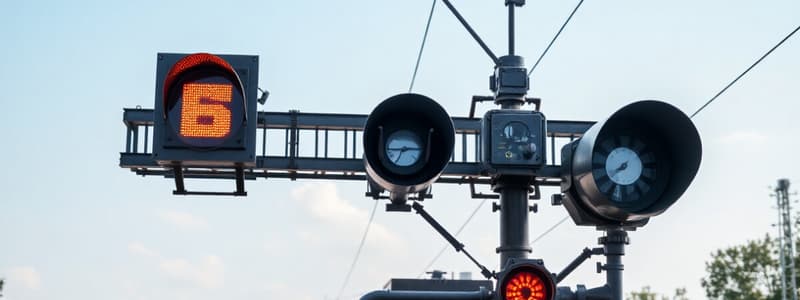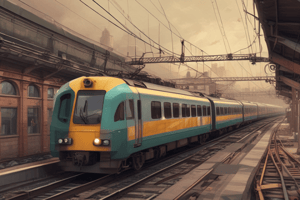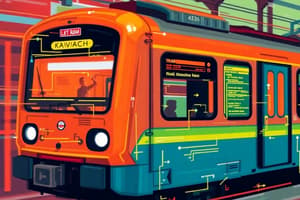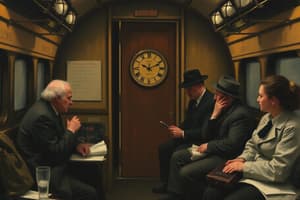Podcast
Questions and Answers
What function does the Buzzer (BZ2) serve at the Receiving Station?
What function does the Buzzer (BZ2) serve at the Receiving Station?
- Indicates the train has stopped
- Activates the telecommunication system
- Provides visual indication only
- Provides audible indication when a train passes (correct)
When does the Train on Line Indicator (TOLK) disappear?
When does the Train on Line Indicator (TOLK) disappear?
- After a predetermined time of 2 to 3 minutes
- When the Buzzer is activated
- When the train exits the Block Section
- When the Operating Handle is turned from (L) to (N) or (R) to (N) (correct)
What is the purpose of the Time Release Indicator (TERK)?
What is the purpose of the Time Release Indicator (TERK)?
- Provide communication between stations
- Indicate current flow in the line
- Show the cancellation of 'Line Clear' after a set time (correct)
- Signal the arrival of a train
How does the Current Indicator (Galvanometer) function?
How does the Current Indicator (Galvanometer) function?
What indicates that a communication line is established between two stations?
What indicates that a communication line is established between two stations?
Which step must be taken before any operation on the Tokenless Block Instrument is made?
Which step must be taken before any operation on the Tokenless Block Instrument is made?
What type of information does the Telephone provide between stations?
What type of information does the Telephone provide between stations?
What position should the operating handle be turned to when acknowledging X’s signal?
What position should the operating handle be turned to when acknowledging X’s signal?
What must be pressed along with Push Button (PB1) until the station X operates his Handle?
What must be pressed along with Push Button (PB1) until the station X operates his Handle?
Which signal indicates that the train has entered the block section?
Which signal indicates that the train has entered the block section?
What action should be taken on receipt of Y’s acknowledgement signal?
What action should be taken on receipt of Y’s acknowledgement signal?
Which signal does Buzzer (BZ1) activate after the train enters the block section?
Which signal does Buzzer (BZ1) activate after the train enters the block section?
What procedure follows the sending of the 'Train Entering Section' signal?
What procedure follows the sending of the 'Train Entering Section' signal?
After turning the Operating Handle to 'TRAIN GOING TO', what must be demonstrated by sending a signal?
After turning the Operating Handle to 'TRAIN GOING TO', what must be demonstrated by sending a signal?
What indication is automatically displayed once the last stop signal is taken off?
What indication is automatically displayed once the last stop signal is taken off?
Which system component must be operated after the train enters the block section?
Which system component must be operated after the train enters the block section?
What must the Station Master do before resuming normal Tokenless Block working?
What must the Station Master do before resuming normal Tokenless Block working?
What record should be kept in SI-24 after a Tokenless failure is rectified?
What record should be kept in SI-24 after a Tokenless failure is rectified?
What procedure must be followed if a portion of the train is left in mid-section?
What procedure must be followed if a portion of the train is left in mid-section?
What should be done when the last stop signal fails?
What should be done when the last stop signal fails?
How should the advice issued for a failure be handled when Tokenless Block Instruments are back in use?
How should the advice issued for a failure be handled when Tokenless Block Instruments are back in use?
What should be done if there is a delay in conveying the Train Entering Section signal?
What should be done if there is a delay in conveying the Train Entering Section signal?
What happens after Buzzer (BZ1) stops?
What happens after Buzzer (BZ1) stops?
What action is taken when the reception signal lever is put back to normal position?
What action is taken when the reception signal lever is put back to normal position?
Which of the following signals is sent to another station as part of communication protocols?
Which of the following signals is sent to another station as part of communication protocols?
What is the process for sending a Train Out of Section signal?
What is the process for sending a Train Out of Section signal?
When does Buzzer (BZ2) continue to ring?
When does Buzzer (BZ2) continue to ring?
What is the first step in the sequence following the signal reception?
What is the first step in the sequence following the signal reception?
What does the acknowledgment of a 'Call Attention' signal indicate?
What does the acknowledgment of a 'Call Attention' signal indicate?
What is indicated when the reception signal is replaced to the ‘ON’ position?
What is indicated when the reception signal is replaced to the ‘ON’ position?
What must a person hold in order to operate a Block Instrument?
What must a person hold in order to operate a Block Instrument?
For how long is the Certificate of Competency valid?
For how long is the Certificate of Competency valid?
What happens if staff do not attend a Refresher Course within 3 years?
What happens if staff do not attend a Refresher Course within 3 years?
Who must certify the extension of the Competency Certificate?
Who must certify the extension of the Competency Certificate?
Who is responsible for ensuring only competent staff operate the Block Instrument?
Who is responsible for ensuring only competent staff operate the Block Instrument?
What is required for any staff overdue for a Refresher Course?
What is required for any staff overdue for a Refresher Course?
Who may exclusively use the Tokenless Instruments and bells?
Who may exclusively use the Tokenless Instruments and bells?
What is the consequence of failing a refresher course examination?
What is the consequence of failing a refresher course examination?
What must happen after a competency certificate's validity is extended?
What must happen after a competency certificate's validity is extended?
How long can the extension of the Certificate of Competency last if not renewed in time?
How long can the extension of the Certificate of Competency last if not renewed in time?
What must happen for the extension of a Certificate of Competency to be valid?
What must happen for the extension of a Certificate of Competency to be valid?
What is the maximum duration a Certificate of Competency can be extended if a Refresher Course is not attended?
What is the maximum duration a Certificate of Competency can be extended if a Refresher Course is not attended?
Who is responsible for re-examining staff for the extension of their competency certificate?
Who is responsible for re-examining staff for the extension of their competency certificate?
What is a mandatory action for staff who become overdue for a Refresher Course?
What is a mandatory action for staff who become overdue for a Refresher Course?
Which official is required to have a valid competency certificate to fulfill their duties under Rule 1.14(i)?
Which official is required to have a valid competency certificate to fulfill their duties under Rule 1.14(i)?
Which procedure must be followed regarding Tokenless Instruments and bells?
Which procedure must be followed regarding Tokenless Instruments and bells?
What is the consequence if the staff fails to pass the refresher training?
What is the consequence if the staff fails to pass the refresher training?
What must be verified through Private Numbers before suspending the Tokenless Instrument?
What must be verified through Private Numbers before suspending the Tokenless Instrument?
What is the first action to take when both Block Instruments are locked or defective?
What is the first action to take when both Block Instruments are locked or defective?
Which individuals must be informed when Tokenless Block working is suspended?
Which individuals must be informed when Tokenless Block working is suspended?
What should be recorded in SI-24 after the failure of the Tokenless Block working is rectified?
What should be recorded in SI-24 after the failure of the Tokenless Block working is rectified?
What condition must be met before resuming Tokenless Block working?
What condition must be met before resuming Tokenless Block working?
Which circumstance requires the suspension of Tokenless instruments?
Which circumstance requires the suspension of Tokenless instruments?
What must be done if the last stop signal fails to go to 'ON' as the train passes?
What must be done if the last stop signal fails to go to 'ON' as the train passes?
Which situation involves an irregularity that must be reported as an accident?
Which situation involves an irregularity that must be reported as an accident?
What must not occur when the Block Instrument's working is suspended due to failure?
What must not occur when the Block Instrument's working is suspended due to failure?
Which of the following failures does NOT require immediate suspension of Tokenless instruments?
Which of the following failures does NOT require immediate suspension of Tokenless instruments?
In which situation would the Block Maintainer be called to address a failure?
In which situation would the Block Maintainer be called to address a failure?
What is required if the last stop signal can be taken off without 'Line Clear' having been obtained?
What is required if the last stop signal can be taken off without 'Line Clear' having been obtained?
What condition warrants the inspection of the Block Instrument by a special permit holder?
What condition warrants the inspection of the Block Instrument by a special permit holder?
Which of the following scenarios would prevent the resumption of work with the Block Instrument?
Which of the following scenarios would prevent the resumption of work with the Block Instrument?
What must be done to acknowledge the audible warning after inserting the Station Master's key?
What must be done to acknowledge the audible warning after inserting the Station Master's key?
What is the sequence of actions taken when a train enters the station?
What is the sequence of actions taken when a train enters the station?
What is indicated when the 'Train Going To' button is operated?
What is indicated when the 'Train Going To' button is operated?
What happens immediately after the last stop signal is taken off?
What happens immediately after the last stop signal is taken off?
What does the operator confirm when sending 'Is Line Clear' signal to another station?
What does the operator confirm when sending 'Is Line Clear' signal to another station?
Which action signifies that the 'Train on Line' condition is active?
Which action signifies that the 'Train on Line' condition is active?
What is the final state of the last stop signal lever after the train enters the block section?
What is the final state of the last stop signal lever after the train enters the block section?
What must the operator do before first stop signal gets replaced to 'ON' position?
What must the operator do before first stop signal gets replaced to 'ON' position?
What does the Block Instrument indicate after the Train Entering Section signal is sent?
What does the Block Instrument indicate after the Train Entering Section signal is sent?
What is confirmed after accepting the 'Line Clear' inquiry on the telephone?
What is confirmed after accepting the 'Line Clear' inquiry on the telephone?
What must be done if shunting is completed before the train clears the Block section?
What must be done if shunting is completed before the train clears the Block section?
What action should the Loco Pilot take if the train clears the block section before shunting is completed?
What action should the Loco Pilot take if the train clears the block section before shunting is completed?
Which is the correct sequence of operations to initiate shunting from Station 'A' to Station 'B'?
Which is the correct sequence of operations to initiate shunting from Station 'A' to Station 'B'?
What should be acknowledged over the telephone in case of shunting completion?
What should be acknowledged over the telephone in case of shunting completion?
What is necessary for Station 'B' if the Line Closed condition is not established after extraction of the shunting key?
What is necessary for Station 'B' if the Line Closed condition is not established after extraction of the shunting key?
Which signal is used to protect the slip siding at Station 'A'?
Which signal is used to protect the slip siding at Station 'A'?
What should be set on the Block Instrument after usual reception of the train?
What should be set on the Block Instrument after usual reception of the train?
When should the shunting key be replaced in the instrument?
When should the shunting key be replaced in the instrument?
What is the primary purpose of the Block Instrument during shunting operations?
What is the primary purpose of the Block Instrument during shunting operations?
What condition must the Block Instrument be in prior to operating shunting keys?
What condition must the Block Instrument be in prior to operating shunting keys?
Flashcards
Buzzer (BZ2) function
Buzzer (BZ2) function
Provides an audible signal at the receiving station when a train passes the home signal and stops, either by returning the signal/control slide to normal or turning the operating handle from 'TRAIN COMING FROM' to 'LINE CLOSED'.
Train on Line Indicator (TOLK)
Train on Line Indicator (TOLK)
A visual indication at both stations, appearing when a train enters a block section which disappears when the operating handle changes from 'L/R' to 'N'.
Time Release Indicator (TERK)
Time Release Indicator (TERK)
A visual indicator at the despatching station, appearing 2-3 minutes after canceling 'Line Clear' by operating the cancellation switch (SI).
Galvanometer function
Galvanometer function
Signup and view all the flashcards
Telephone communication
Telephone communication
Signup and view all the flashcards
Tokenless Block Instrument Assurance
Tokenless Block Instrument Assurance
Signup and view all the flashcards
Block instrument types
Block instrument types
Signup and view all the flashcards
What is the first step for station X?
What is the first step for station X?
Signup and view all the flashcards
How does station X acknowledge the signal?
How does station X acknowledge the signal?
Signup and view all the flashcards
What is the next step for station X?
What is the next step for station X?
Signup and view all the flashcards
What happens when a train enters the block section?
What happens when a train enters the block section?
Signup and view all the flashcards
What is the role of Buzzer (BZ1)?
What is the role of Buzzer (BZ1)?
Signup and view all the flashcards
What is the role of the "Train on Line" Indication?
What is the role of the "Train on Line" Indication?
Signup and view all the flashcards
What is the role of station Y after receiving the "Call Attention" signal?
What is the role of station Y after receiving the "Call Attention" signal?
Signup and view all the flashcards
What is the role of station Y after receiving the "Train Entering Section" signal?
What is the role of station Y after receiving the "Train Entering Section" signal?
Signup and view all the flashcards
Train Entering Section Signal Delay
Train Entering Section Signal Delay
Signup and view all the flashcards
Buzzer (BZ1)
Buzzer (BZ1)
Signup and view all the flashcards
Reception Signals
Reception Signals
Signup and view all the flashcards
'Call Attention' Signal
'Call Attention' Signal
Signup and view all the flashcards
Train Out of Section Signal
Train Out of Section Signal
Signup and view all the flashcards
PB1 and PB2 Push Buttons
PB1 and PB2 Push Buttons
Signup and view all the flashcards
Handle Operation (Train Out of Section)
Handle Operation (Train Out of Section)
Signup and view all the flashcards
Remarks Column in Train Signal Register
Remarks Column in Train Signal Register
Signup and view all the flashcards
Tokenless Block Failure
Tokenless Block Failure
Signup and view all the flashcards
Resuming Tokenless Block
Resuming Tokenless Block
Signup and view all the flashcards
Train Parting
Train Parting
Signup and view all the flashcards
Incomplete Train Arrival
Incomplete Train Arrival
Signup and view all the flashcards
Last Stop Signal Failure
Last Stop Signal Failure
Signup and view all the flashcards
Block Competency Certificate
Block Competency Certificate
Signup and view all the flashcards
Refresher Course
Refresher Course
Signup and view all the flashcards
Who issues Block Competency Certificates?
Who issues Block Competency Certificates?
Signup and view all the flashcards
TI(M) Competency for Block
TI(M) Competency for Block
Signup and view all the flashcards
Tokenless Block Instruments Purpose
Tokenless Block Instruments Purpose
Signup and view all the flashcards
Tokenless Block Instrument Operator
Tokenless Block Instrument Operator
Signup and view all the flashcards
Reception Signals and Tokenless Block Instruments Failure
Reception Signals and Tokenless Block Instruments Failure
Signup and view all the flashcards
What happens when a staff member becomes overdue for a Refresher Course?
What happens when a staff member becomes overdue for a Refresher Course?
Signup and view all the flashcards
Bell Codes
Bell Codes
Signup and view all the flashcards
Block Instrument Operation
Block Instrument Operation
Signup and view all the flashcards
Tokenless Block Instrument
Tokenless Block Instrument
Signup and view all the flashcards
TI(M) & Block Competency
TI(M) & Block Competency
Signup and view all the flashcards
Tokenless Block Instrument Suspension
Tokenless Block Instrument Suspension
Signup and view all the flashcards
Failure Types Affecting Tokenless Block Instruments
Failure Types Affecting Tokenless Block Instruments
Signup and view all the flashcards
What is the consequence of a train arriving without "Line Clear"?
What is the consequence of a train arriving without "Line Clear"?
Signup and view all the flashcards
What is the purpose of the 'Line Clear' signal?
What is the purpose of the 'Line Clear' signal?
Signup and view all the flashcards
Operating a Tokenless Block Instrument
Operating a Tokenless Block Instrument
Signup and view all the flashcards
Tokenless Block Instrument Failure: Reception Signals?
Tokenless Block Instrument Failure: Reception Signals?
Signup and view all the flashcards
Refresher Course for Block Operators
Refresher Course for Block Operators
Signup and view all the flashcards
Bell Codes: Tokenless Block Instruments
Bell Codes: Tokenless Block Instruments
Signup and view all the flashcards
What is the first step for Station A after receiving the "Is Line Clear" signal?
What is the first step for Station A after receiving the "Is Line Clear" signal?
Signup and view all the flashcards
What does Station A do after acknowledging the "Is Line Clear" signal?
What does Station A do after acknowledging the "Is Line Clear" signal?
Signup and view all the flashcards
What is the 'Call Attention' signal?
What is the 'Call Attention' signal?
Signup and view all the flashcards
What are reception signals?
What are reception signals?
Signup and view all the flashcards
What happens when a train enters the station?
What happens when a train enters the station?
Signup and view all the flashcards
What is the “Train Going To” button used for?
What is the “Train Going To” button used for?
Signup and view all the flashcards
What happens when a train leaves the block section?
What happens when a train leaves the block section?
Signup and view all the flashcards
Shunting Procedure
Shunting Procedure
Signup and view all the flashcards
Shunting Key
Shunting Key
Signup and view all the flashcards
Slip Siding
Slip Siding
Signup and view all the flashcards
Catch Siding
Catch Siding
Signup and view all the flashcards
Line Closed
Line Closed
Signup and view all the flashcards
Train Going To
Train Going To
Signup and view all the flashcards
Train Coming From
Train Coming From
Signup and view all the flashcards
Station Master's Key
Station Master's Key
Signup and view all the flashcards
Slip Siding Key
Slip Siding Key
Signup and view all the flashcards
Verify Position (Block Instrument)
Verify Position (Block Instrument)
Signup and view all the flashcards
Tokenless Block Suspension
Tokenless Block Suspension
Signup and view all the flashcards
Tokenless Block Failure: Shunting Key
Tokenless Block Failure: Shunting Key
Signup and view all the flashcards
Tokenless Block Failure: Procedures
Tokenless Block Failure: Procedures
Signup and view all the flashcards
Tokenless Block Resume
Tokenless Block Resume
Signup and view all the flashcards
Shunting Key and Tokenless Block
Shunting Key and Tokenless Block
Signup and view all the flashcards
Study Notes
Rules for Working Trains on Single Line
- Rules govern train operations on single lines using tokenless block instruments (handle and push button types)
- Eliminates token delays, ensuring only one train in a section at a time.
- Stations using the tokenless system have two instruments, one for each adjoining section with phone communication.
- Authority to proceed between stations is granted by signal indication.
- Fixed, hand, and fog signals are still needed to protect trains from obstructions and comply with existing rules.
- Loco pilots must follow general and subsidiary rules and signal instructions.
- Trains start on guards' signals after the correct departure signals are received or permission from the station master.
- Different guard duties may alter the specific rules.
Types of Instruments
- Daido/Kyosan's handle type and Podanur's similar push button type instruments are used.
Arrangement of Instrument
- Two instruments are used per block section (connected by two line wires).
- Instruments can be in the station building or a cabin.
- Station Master or Cabinmaster operates the instrument.
Description of Instruments
- The diagrams show the components and operation of Daido/Kyosan's handle type instruments.
- Components include an operating handle, bell plunger, push buttons, block bell, switch, counter, keys, buzzers, train on line indicator, time release indicator, and a telephone.
Operating Handle (Daido/Kyosan's)
- Three Positions: Line Closed (vertical), Train Coming from (horizontal right), Train Going to (horizontal left)
- The arrow on the handle indicates the current position.
- The handle is locked in the Line Closed position until electrically released by the other station.
Bell Plunger/Push Button
- Pressing the plunger rings a bell at the other block station.
- Pressing bell plunger is often needed for releasing the other station's operating handle.
Other Instrument Components
- A block bell, cancellation switch with counter, switch with counter, Station Master's Key, Occupation Key, buzzer, train on line indicator, time release indicator and telephone.
- Each component has a specific function (e.g., canceling 'line clear', indicating occupation, or providing communication).
Signalling Trains with Daido/Kyosan's Tokenless Instruments
- Exchange station names on the phone before any block operation.
- Correct station confirmation for communication assurance.
- Standardized operating procedures are explained in detail for station X and Y.
Cancelling Line Clear
- Station Master at station with handle in "Train Going To" position must ensure the last stop signal is "ON" and signal slide is back to normal.
- Procedure includes steps to cancel a line clear message.
Normalizing Block Instrument Post Train Arrival
- Resetting procedures for the Block Instrument when a train returns to the dispatching station.
Motor Trolleys/ Material Trollies Operation
- Obtaining permission and giving notices regarding train passage.
- Instructions on passing trolleys through the block section are explained.
Tokenless Instrument Failure
- Identifying and handling various Instrument failures (e.g., code signal failure, telephone disconnection, and issues with the last stop signal).
Failure of Last Stop Signal
- Procedures when the last stop signal malfunctions (e.g., not going to "ON" position, issues with train arrival and signaling).
Suspension of Block Working/Last Stop Signal
- Describes conditions requiring the suspension of block working (e.g., material passing, accidents).
- Procedures to resume normal operations are given.
Push Button Type Instrument
- The push-button instrument also has a relay cabinet and a control panel
- The relay cabinet houses all the relays while the control panel has buttons, indicators, and a phone..
Studying That Suits You
Use AI to generate personalized quizzes and flashcards to suit your learning preferences.




